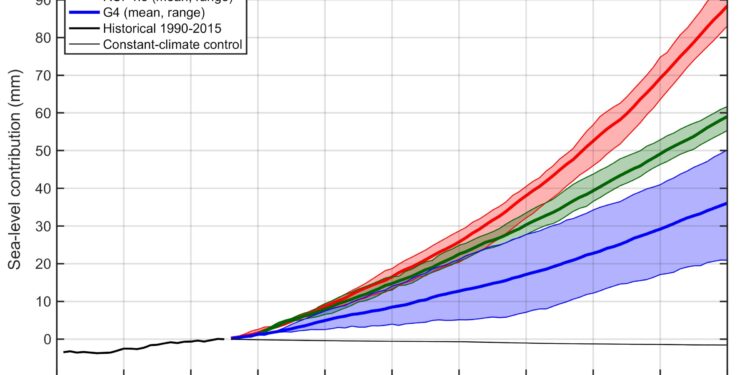Simulated mass loss of the Greenland ice sheet from 1990 to 2090, expressed as contribution to sea level, under different conditions: RCP8.5 (red; most pessimistic scenario, constant warming), RCP4.5 (green ; intermediate scenario, possibly achievable under current conditions) and GeoMIP G4 (blue; RCP4.5 plus the injection of 5 million tonnes of sulfur dioxide per year into the stratosphere between 2020 and 2070). Credit: Ralf Greve
One of the many effects of global warming is sea level rise due to the melting and retreat of Earth’s ice sheets and glaciers. As sea levels rise, large, densely populated coastal areas could eventually become uninhabitable without significant shoreline modification. To avoid this eventuality, carbon emissions must reach a net negative level, a state difficult to achieve under current circumstances.
There are many proposals to significantly mitigate the effects of climate change, and the most far-reaching of these involves interventions that will alter some aspect of the entire planet: geoengineering techniques. Although promising, we do not understand natural cycles well enough to fully assess the benefits of such interventions.
An international team of researchers led by Professor John C. Moore, of the University of Lapland, Rovaniemi, Finland, and Professor Ralf Greve, of the Institute of Low Temperature Sciences, Hokkaido University, used simulations to examine the potential effects of geoengineering. technique called stratospheric aerosol injection of melting ice caps. Their findings were published in the Geophysical Research Journal: Earth Surface.
“Stratospheric aerosol injection, or SAI, would artificially introduce aerosols into the stratosphere by high-altitude aircraft or balloons to create a cooling effect via global dimming and an increase in albedo, the degree to which the Earth reflects sunlight,” Moore explains.
Results of SICOPOLIS simulations comparing the evolution of the Greenland ice sheet between GeoMIP G4 and RCP4.5: ice thickness (H). The injection of stratospheric sulfur dioxide aerosol will have the greatest protective effect on the margins (which remain thicker; yellow and red) of the ice sheet. Credit: Geophysical Research Journal: Earth Surface (2023). DOI: 10.1029/2023JF007112
Moore, Greve and colleagues used the SICOPOLIS model to simulate changes in the Greenland ice sheet for the period 1990-2090 under three different scenarios: RCP8.5 (worst case, constant warming); RCP4.5 (intermediate scenario, possibly achievable under current conditions); and GeoMIP G4 (RCP4.5 plus the injection of 5 million tonnes of sulfur dioxide per year into the stratosphere between 2020 and 2070).
The simulations showed that the SAI of sulfur dioxide would have an obvious protective effect on the Greenland ice sheet. Under RCP8.5, there would be ice loss equivalent to a sea level rise of approximately 90 mm; according to RCP4.5, the ice loss would be approximately 60.6 mm of sea level rise; but under GeoMIP G4, ice loss would be limited to approximately 37.6 mm of sea level rise. When these scenarios were tested with a different model, Elmer/Ice, the results were similar. Ice sheet margins would benefit most from GeoMIP G4.
“Although this study shows that SAI could contribute to the protection of the Greenland ice sheet and, therefore, potentially all other ice covers on Earth, geoengineering is a very controversial topic,” concludes Greve. “The biggest problem is that it only addresses the symptoms of global warming, not its root causes, and may even delay the changes needed to address the causes. Moreover, due to the immense complexity of natural systems on Earth, it is impossible to predict exactly what positive and negative outcomes might result.
More information:
John C. Moore et al, Reduction of Greenland ice loss under stratospheric aerosol injection, Geophysical Research Journal: Earth Surface (2023). DOI: 10.1029/2023JF007112
Provided by Hokkaido University
Quote: Geoengineering could slow loss of Greenland ice sheet, modeling study shows (January 30, 2024) retrieved January 30, 2024 from
This document is subject to copyright. Except for fair use for private study or research purposes, no part may be reproduced without written permission. The content is provided for information only.



